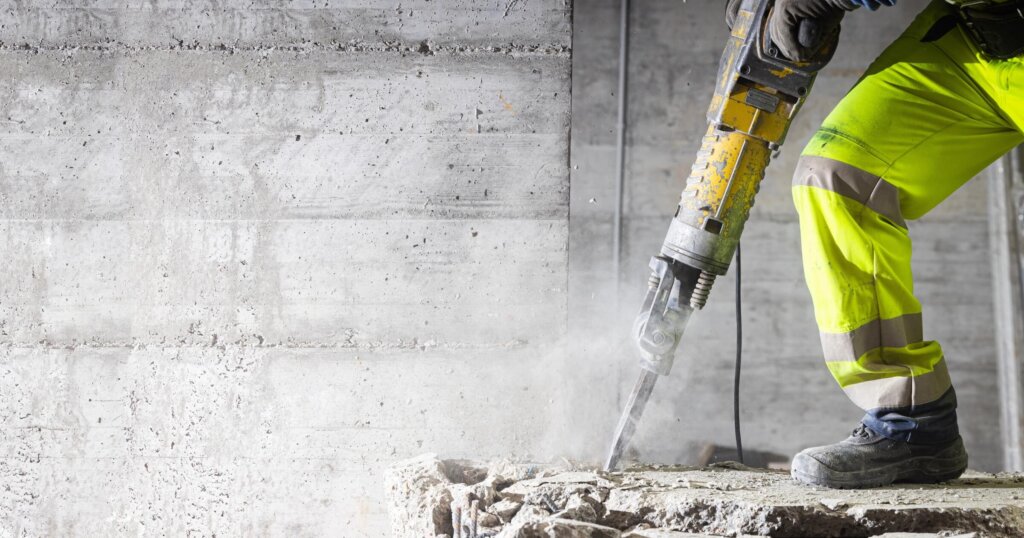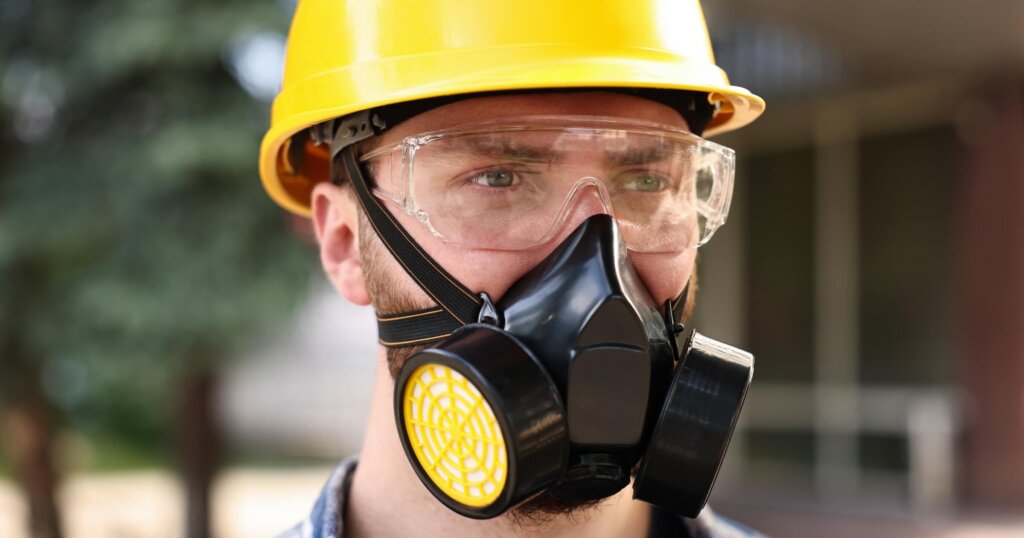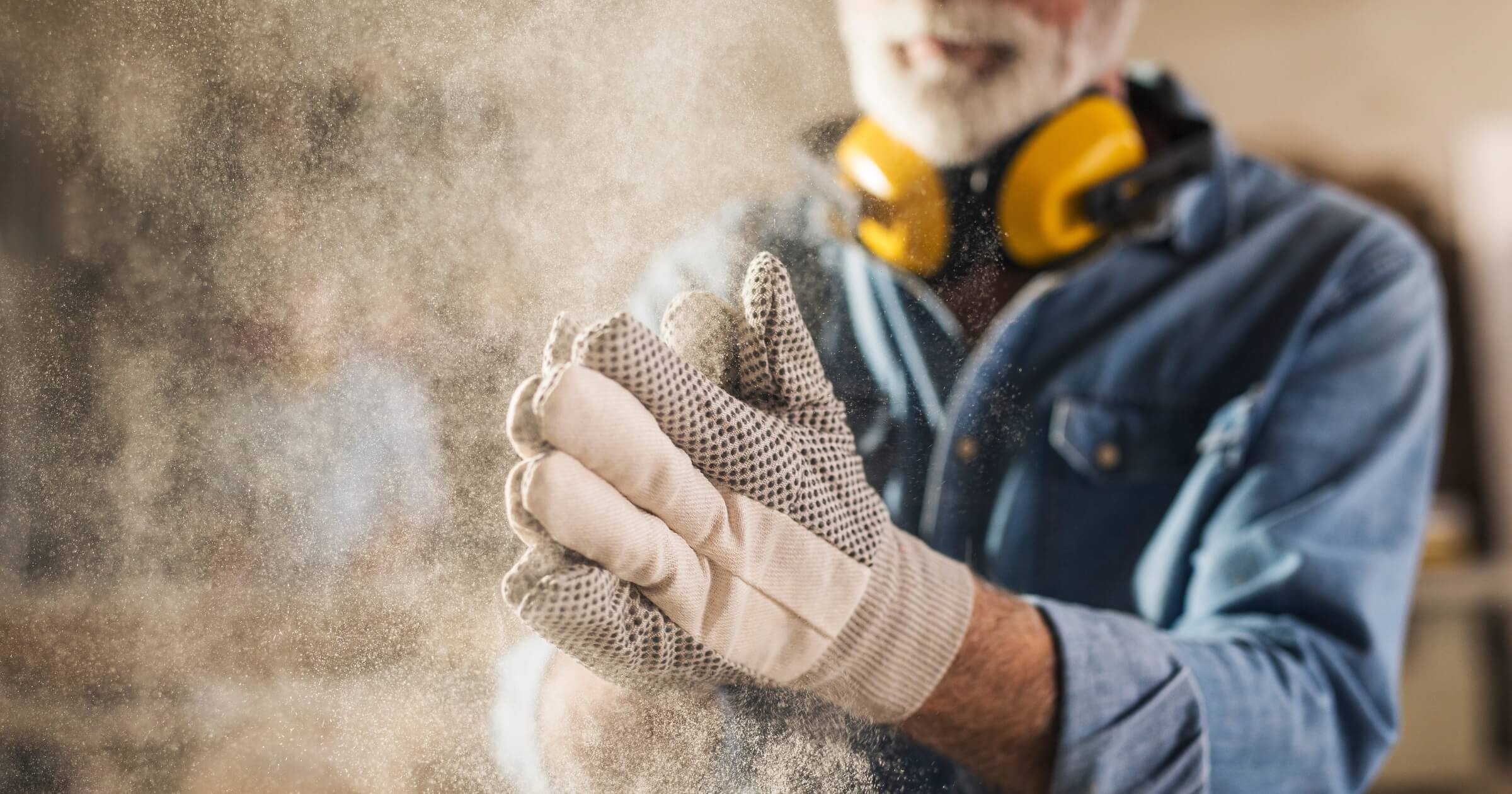Construction crews working on busy sites are often surrounded by clouds of dust from sawing, sanding, cutting, or demolition. It might not seem like a big deal at the moment, but breathing in that dust day after day can have serious long-term effects on your health. Knowing what’s in the air, how it impacts the body, and what can be done to limit exposure can help you stay safe on the job.
Quick look:
- Construction dust poses serious long-term health risks including silicosis, COPD, and lung cancer
- Common jobsite tasks like cutting, sanding, or demolition release dangerous airborne particles
- Silica, asbestos, and cement dust are among the most harmful substances workers encounter
- Proper planning, ventilation, PPE, and housekeeping practices are important for protection
What is construction dust and why is it dangerous?
Construction dust is made up of tiny airborne particles released during common tasks like cutting concrete, grinding mortar, sanding drywall, or demolishing materials. These particles are often so fine they’re invisible to the naked eye but small enough to be inhaled deep into the lungs.
That’s where the real danger lies. When inhaled, dust can irritate the airways, cause inflammation, and in some cases, scar lung tissue permanently. Over time, repeated exposure will lead to serious conditions like chronic bronchitis, silicosis, and even lung cancer.
According to OSHA, respirable crystalline silica is generated during cutting, sawing, grinding, drilling, and crushing materials like concrete, brick, mortar, and stone. It is estimated that more than 2.3 million U.S. workers are exposed on the job to dust.

Photo courtesy of https://www.shutterstock.com/
Types of construction dust and their health risks
Silica dust (crystalline silica)
Silica dust is one of the most common and dangerous forms of construction dust. It’s released into the air when cutting, grinding, drilling, or demolishing materials like concrete, brick, tile, and natural stone. These activities break down the material and release tiny particles of crystalline silica, which can easily be inhaled.
Once in the lungs, silica dust can cause serious and permanent damage. Long-term exposure is linked to silicosis, an incurable lung disease that causes scarring and makes it harder to breathe. It also increases the risk of lung cancer, chronic obstructive pulmonary disease (COPD), and even kidney disease. The damage often builds up over time, meaning symptoms might not show up until years after the exposure has already taken its toll.
Cement dust
Cement dust is produced when handling dry cement products, especially during mixing, opening bags, grinding, or sanding concrete surfaces. The fine particles can become airborne quickly, especially in enclosed or poorly ventilated areas.
Breathing in cement dust over time can lead to chronic bronchitis and long-term respiratory irritation. It’s also highly alkaline, which means it can cause skin burns, rashes, and eye damage on contact. While research is still ongoing, some studies suggest that prolonged exposure to cement dust may have carcinogenic effects, particularly when mixed with other airborne particles on site. Wearing the right protective gear and using proper ventilation is important when working with cement-based materials.
Asbestos fibers
Asbestos was once a common material used in insulation, ceiling tiles, flooring, and pipe coverings, especially in buildings constructed before the 1990s. When these materials are disturbed during demolition, renovation, or repair, tiny asbestos fibers can be released into the air.
These fibers are incredibly dangerous when inhaled. Long-term exposure can lead to mesothelioma (a rare and aggressive cancer), asbestosis (a chronic lung disease that causes scarring), and lung cancer. What makes asbestos exposure especially harmful is that symptoms often don’t appear for 20 to 40 years after exposure. By the time health problems show up, the damage is usually advanced and irreversible.
Gypsum and drywall dust
Tasks like cutting drywall panels, sanding seams, or tearing down old walls create large amounts of fine dust. Most drywall contains gypsum, a soft mineral that produces fine, powdery dust when disturbed.
In small amounts, gypsum dust is generally considered a nuisance. But repeated exposure, especially in enclosed spaces without proper ventilation, can cause respiratory irritation, coughing, and throat discomfort. Over time, chronic exposure is known to lead to inflammation in the lungs, which can worsen existing conditions like asthma or bronchitis. Proper dust control and respiratory protection are important when working with drywall, particularly during sanding.
General construction dust (wood, soil, road dust)
This type of dust comes from a variety of everyday tasks on site, including sawing wood, sweeping floors, digging trenches, or working on dry, dusty roads. It’s a mix of particles from organic and inorganic materials like wood fibers, dirt, gravel, and debris.
While it might not seem as hazardous as silica or asbestos, general construction dust can still pose serious health risks. Prolonged exposure can trigger asthma, allergies, and sinus problems. For workers with pre-existing respiratory issues, it can make symptoms worse and increase the risk of complications. Even short-term exposure in dry, windy conditions can lead to irritation if protective measures aren’t taken.
Long-term diseases caused by construction dust exposure
Prolonged exposure to construction dust can lead to a number of serious, long-term health conditions. Many of these diseases develop slowly, with symptoms appearing only after years of repeated inhalation. Once the damage is done, it’s often permanent and can severely impact quality of life.
Silicosis
Caused by breathing in fine silica particles over time, silicosis is an incurable lung disease that results in scarring of lung tissue. It gets worse over time and can eventually make it difficult to breathe, even at rest. In severe cases, it can be fatal.
Chronic Obstructive Pulmonary Disease (COPD)
COPD includes conditions like chronic bronchitis and emphysema. It limits airflow in the lungs and makes breathing feel labored. For construction workers exposed to dust, especially silica and cement, the risk of developing COPD increases significantly.
Lung cancer
Dust containing crystalline silica or asbestos has been directly linked to lung cancer. Because these particles stay in the lungs long after exposure, the risk can persist for years. Early symptoms often go unnoticed, making regular screening and protection critical.
Pneumoconiosis
This is a group of lung diseases caused by inhaling mineral dust, including coal, silica, and asbestos. Over time, it causes lung inflammation, scarring, and reduced lung function. Like silicosis, it’s progressive and has no cure.
Cardiovascular disease
Newer research suggests that breathing in fine dust particles doesn’t just affect the lungs. Long-term exposure to airborne pollutants may also increase the risk of heart disease and stroke, likely due to ongoing inflammation and stress on the cardiovascular system.
How to protect construction workers from dust exposure

Photo courtesy of https://www.shutterstock.com/
Making respiratory safety a priority requires a combination of smart planning, proper equipment, and safe work habits. Taking a few extra steps can make a big difference in the long-term health of your crew.
Engineering controls
One of the most effective ways to control dust is to stop it at the source:
- Use wet cutting methods to keep dust from becoming airborne.
- To capture dust, install local exhaust ventilation systems wherever it’s generated.
- Attach dust extraction systems to tools like saws and grinders to limit dust spreading.
Administrative controls
Worksite planning plays an important role in minimizing risk:
- Conduct regular dust risk assessments and monitor air quality on an ongoing basis.
- Rotate workers in and out of dusty areas to reduce exposure.
- Offer regular training so everyone on site understands the risks and how to protect themselves.
Personal Protective Equipment (PPE)
PPE provides a crucial layer of defense when dust can’t be completely eliminated:
- Wear fit-tested respirators like N95 or P100 masks to filter fine particles.
- Use protective clothing and safety goggles to prevent skin and eye irritation.
Housekeeping and worksite practices
Keeping the site clean also helps prevent dust buildup:
- Clean surfaces with HEPA vacuums instead of dry sweeping or compressed air.
- Where possible, substitute high-dust materials with pre-cut or low-dust alternatives to reduce exposure during cutting or sanding.
Bottom line
Dust exposure on construction sites is a long-term health risk. From silica and asbestos to drywall and cement, airborne particles can lead to serious, life-altering diseases that can show up years after the damage is done. With the right combination of controls, training, and protective equipment, these risks can be managed, and even prevented.
Want to learn more about safety on the jobsite? Check out our latest reads for more information about safety practices in construction:
- Raffi Elchemmas on Safety in Construction
- Construction Safety Trends to Adopt for 2025
- Effective Safety Leadership in Construction
And if you haven’t already, don’t forget to subscribe to our newsletter for more expert tips on construction safety, health, and industry best practices.


